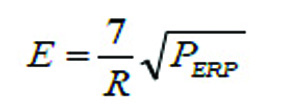Mart Coenen, EMCMCC bv, Eindhoven, the Netherlands
Tim Maas, ASML bv, Veldhoven, the Netherlands
Yili Hu, Student Eindhoven University of Technology, the Netherlands
Arthur van Roermund, Eindhoven University of Technology, the Netherlands
ABSTRACT
In-situ EMC testing is, for large fixed systems and installations within the scope of the European EMC Directive, not a primary requirement other than unintended RF emissions may not affect intended radio frequency communication services, like the requirements of IEC/EN 55011 outside the end-user’s premises. Whatever happens on the premises of the industrial end-user is a matter of negotiations and agreements between the various system suppliers and the end-user, in particular when EMC is lacking between two or more (sub-) systems installed.
A formal standardized method for verification is IEC CISPR/TR 16-2-5 Ed. 1.0, but one of the root problems is the usage of common EMC measurement antenna nearby a conductive object, when performing in-situ EMC investigations, which remains doubtful.
In a pan-European TEMCA-2 (ended 2007) project, several investigations have been carried out which have not (yet) resulted in a standardized test method but their results have been reported at several international EMC symposia.
In this paper, part of an adapted in-situ measurement approach is presented, which minimizes the interaction with the local EM-environment even further by using surface current sense wires. This new test method has already been submitted as NP to the international standardization bodies concerned. It has also been presented at the EMC compo 2009 in Toulouse and the Asian Pacific EMC symposium (APEMC) 2010 in Beijing.
INTRODUCTION
Most of the formal EMC requirements are defined at a transportable product level rather than for physically large (distributed) systems or installations. At the product level RF emission tests have been defined conductively on mains supply and other cables connected below 30 MHz, but the interaction by radiation is more cumbersome when the equipment under test cannot be placed on an open area test side (OATS) or in a semi-anechoic room (SAR). Additionally, many physical large systems and installations cannot be tested functionally at such “defined” test EMC facilities due to their functional and operational constraints.
With the basic RF emission and immunity standards only moveable apparatus is considered. Considering large (distributed) systems or installations, there will be a fixed electrical connection which is typically not suited for formal tests using artificial mains networks (AMNs) or coupling/decoupling network (CDNs) on all cables connected. Most large (distributed) systems or installations have their outer surface metal covered and all cables will be routed in metal cable carrying conduits in-between the sub-systems of the total system or installation concerned.
OVERVIEW
When using the formal standardized test methods, the positioning of the floor-standing equipment and the cable routings are defined and to a certain extent determined by the tests that have to be applied; conducted RF emission, EFT, conducted RF immunity, ESD. Also the placement of the floor-standing equipment w.r.t. the ground reference plane (GRP) differs from an insulation foil (ESD), 0,1 meter (EFT and conducted RF immunity) to 0,4 meter with conducted RF emission testing. In addition, there is also an everlasting discussion about what to do with (excessive) cable routing.
With the test method proposed by the TEMCA-2 project, an antenna wire has to be positioned over the distributed system or installation concerned and has to be routed at a distance of 0,1 meter from the metal surface of that distributed system or installation. At the near and far-end of the U-shape antenna wire RF termination impedances of 150 Ω are used towards the ground reference plane (GRP), see Figure 1.
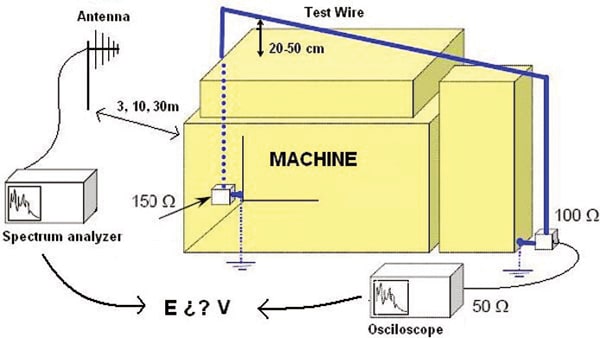
This test method proposed has great resemblance with the large loop antenna which is in place for years as part of IEC/EN 55015 to measure magnetic RF emission from tubular luminaries. The use of 150 Ω termination impedance is equal to the common-mode impedance values used in IEC/EN 61000-4-6. The latter impedance values have also been confirmed by later studies at MST EMC where common-mode cable termination resistances were recommended in the range 50 -500 Ω in the frequency range 30 MHz till 1 GHz to stabilize cable influences during radiated measurements.
For large systems and installations, the common-mode termination of all cables connected can be implemented by the use of CDNs, snap–on EM-clamps, MDS clamps and equivalent devices.
PHYSICAL APPROACH
From physically small (compared to the wavelength concerned) electrical and electronic devices, the RF emission performance, both conducted as well as radiated, can be obtained by measuring the equivalent disturbance source voltage level at the ports of the equipment. E.g. the impedance stabilizing network (ISN) has been defined in IEC/EN 55022 for telecom ports up to 30 MHz.
With IEC/EN 55014-1, the MDS absorbing clamp has been introduced to measure the available RF power from small appliances by tuning the distance (= CM impedance) between the appliance and the clamp until the maximum power was obtained. Exchanging the MDS clamp by an EM-clamp or CDN (≈ 150 Ω common-mode impedance) in a fixed position near to the appliances has resulted in correlation as close as ±2 dB over the frequency range of interest, typically 30 to 300 or even up to 1000 MHz. With IEC/EN 55015 (2005), the use of CDNs has been introduced in the frequency range 30 to 300 MHz to eliminate the need of radiated tests and the MDS-clamp and substitute it with a network at a fixed position.
When the antenna port source amplitude is known and thereafter multiplied with a “statistically fair” radiation resistance/ impedance of 150 Ω, the RF emission is quantified conductively from 150 kHz up to 30 MHz or even 300 MHz or above. A high frequencies, more compact (horn) antennae can be used with sufficient directivity.
What all these methods have in common is “Stokes law.”
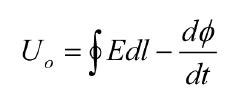 Aside the direct emission from the conductive surfaces of the physically large system or installation also common-mode excitation voltages may occur between the ground reference plane (GRP) structure: the building’s structure, and the frame of the equipment itself. This common-mode disturbance voltage can be easily measured by using CDN-M1, see Figure 4 or by using CFP or CVP-probes.
Aside the direct emission from the conductive surfaces of the physically large system or installation also common-mode excitation voltages may occur between the ground reference plane (GRP) structure: the building’s structure, and the frame of the equipment itself. This common-mode disturbance voltage can be easily measured by using CDN-M1, see Figure 4 or by using CFP or CVP-probes.
NEW APPROACH
Different from the application in Figure 1, the surface current sense wires are installed on the conductive surfaces of the physically large system or installation parts in various positions and orientations. By taking an appropriate wire diameter/insulation thickness ratio of this current sense wire, a micro-strip configuration can be achieved with a characteristic impedance of 50 Ω. The current sense wire can be applied by putting this insulated wire in-between a pair of RF connectors of which the outer shells shall be connected to the conductive surfaces of the system or installation to be tested, see Figure 2.

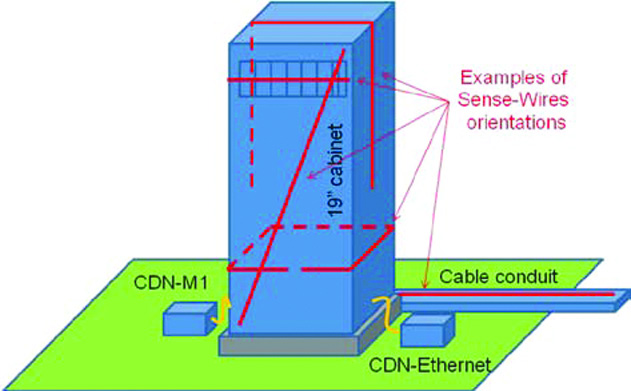
When the surface current sense wire is routed in various orthogonal orientations over a 19-inch rack, e.g. at 0.5 or 1 meter intervals, see Figure 3, the voltages over the system’s or installation’s conductive surface holes, slits and display windows will induce their noise voltage in the surface current sense wire with minimal RF losses and without seriously affecting the characteristic impedance of that micro-strip wire topology.
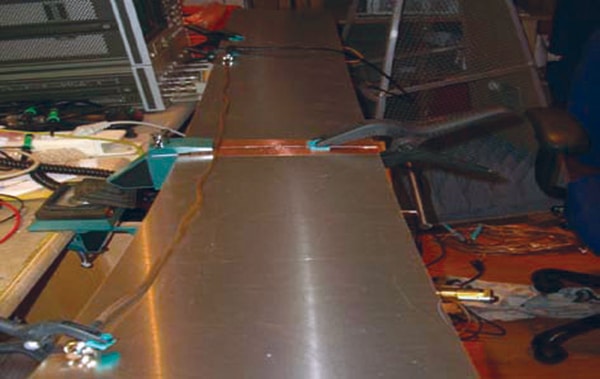
One constraint remains in particular: the on-top-of the surface current sense wire has to be routed direct and tight over the conductive surface of the system or installation under test to maintain the characteristic impedance of 50 Ω with minimum reflections; S11.

CALIBRATION
The surface current sense wires do not require excessive calibration other than the selection of the conductive wire diameter versus the wire insulation used to obtain the 50 Ω micro-strip impedance.
Measurements have shown that the RF transfer losses along a three-meter-long wire with 2.5 mm2 copper cross-section are limited to a few dB, see Figure 4 for the test set-up and Figure 5 as an example of a transfer function. Additional measurements and simulations have been performed on a shielded metal box measuring 0.4 x 0.3 x 0.2 m with a slit, see Figure 6. An inside wire has been mounted crossing the 10 mm wide slit diagonal. The inside wire is terminated with 50 Ω.
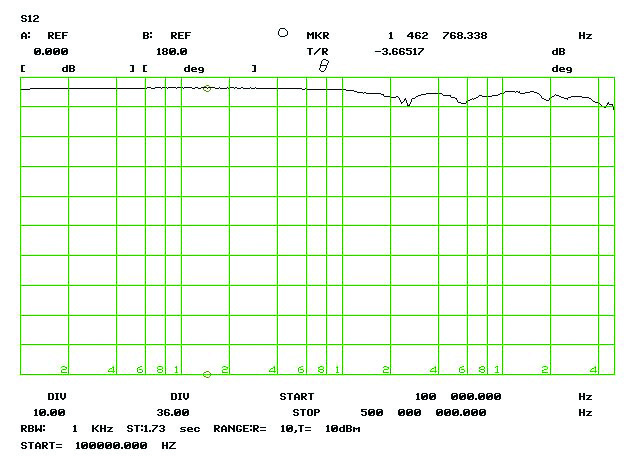

The ultimate need to gain formal acceptance is to prove that the RF emission as measured with the surface current sense wires and/or CDNs are always equal or higher than the measured EM radiated fields. As the correlation applies to passive networks, reciprocity applies to immunity testing. Simulations have resulted in the current distributions like given in Figure 7.
The E-field to be expected from an unintended radiation source can be expressed by the first-order approximation:
where: E = E-fieldstrength [V/m] R = distance of observation [m] and PERP = effective radiated power [W].
In case of full surface current sense wire coupling, all RF power would be induced in the sense wire and appear across the 50 Ω load of the surface current sense wire.
APPLICATIONS
This measurement methodology has been used with RF emission measurements, RF immunity measurements and impulse immunity measurements; EFT. Similar to the measurement results when using CDNs, the EMC results obtained are always more stringent as when measuring it at 3 or 10 meter distance with antennae. With surface current sense wires, the individual induced voltages are measured
Correlations as high as 1 dB were found both for RF emission (see Figure 8), as well as radiated RF immunity between the worst-case measurements obtained by using the surface current sense wire technique (without applying any shielded room) and formal measurements by using antennae at 10 meter distance in a qualified semi-anechoic room (SAR) of a Notified Body when the appropriate conductive limits are applied.
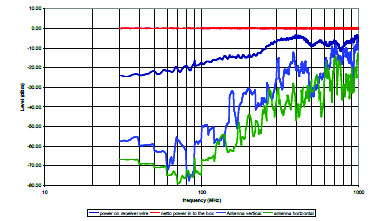
For those cases, when using bi-conical and log-periodic antenna at 1 meter distance from a physically large systems in-situ, the EM background environment was mostly dominated by other equipment and results could only be obtained by “subtracting” spectral plots with/without the system into operation but this approach is suffering from latency due to the necessary start-up and shut-down sequences for the large systems involved, leading to marginal system level conclusions.
Due to the extreme vast coupling between the system and/or installation under test and the various surface current sense wires applied, the obtained RF emission levels are typically very high and easy to measure with high signal-to (other) noise ratio due to other nearby contributors. There is no disadvantage between the test time necessary when using typical EMC antennae and moving them around the system or installation under test and applying the sense wires over the surfaces and making the measurements at their accessible ports.
With the RF immunity test using the surface current sense wires, less than 5 Watt available power is more than enough to test against high stress levels: > 30 Voltemf and over 300 mA induced surface currents may result over the whole frequency range of application.
Similar with EFT tests, the impulse stress can proportionally be applied to the surface current sense wires. Care shall be taken that the impulse withstand capabilities of the termination resistances at the end of these sense wires.
CONCLUSIONS
A simple straightforward measurement method using surface current sense wires has been introduced with has shown to be very economic, fast and reproducible and easy to apply. Aside an EMI-receiver or RF spectrum analyzer, only band-pass or high-pass filters are necessary to prevent overloading of their inputs due to the broadband nature of the signals that might be induced on the sense wires. The sense wire configuration over the system or installation to be tested shall remain unchanged during the 3 tests to be performed: RF emission, RF immunity and immunity against EFT. The RF emission sensed by using the surface current sense wires and/or CDNs is always above the radiated peak emission levels. The effect from the local EM-ambient to the RF emission results is at least an order less, when adjacent EMC compliant systems are considered. When applying the RF immunity test, hardly any disturbance is added to the local EM-ambient. Only very low RF power is required to test the systems and installations to severe RF immunity levels. RF immunity can, therefore, be verified over the whole frequency range rather than just at the ISM frequencies.
As the surface current sense wires make contact to the system’s or installation’s accessible metal surfaces, the test method is considered electrically safe. By using the surface current sense wires in combination with CDNs, large distributed systems and installations can be EMC characterized and qualified in-situ with high confidence.
FUTURE WORK
In the meanwhile, the frequency range of application has been extended to 3 GHz without drawback. Whether it is also suited to be extended downwards in frequency e.g. to 50 Hz, needs to be further investigated.
ACKNOWLEDGEMENT
This work carried out has been performed as part of a WBSO Research and Development (S&O) program promoted by the Dutch Government under number ZT09051042.SO in collaboration with TMC Electronics and ASML Electronic Development.
REFERENCES
[1] Electromagnetic Compatibility (EMC) Directive 2004/108/EC Electromagnetic Compatibility (EMC) Directive 2004/108/EC
[2] IEC CISPR/TR 16-2-5, Ed. 1.0, Specification for radio disturbance and immunity measuring apparatus and methods -Part 2-5: In situ measurements for disturbing emissions produced by physically large equipment.
[3] IEC CISPR 14-1 Consol. Ed. 5.1 (incl. am1), Electromagnetic compatibility -Requirements for household appliances, electric tools and similar apparatus -Part 1: Emission
[4] IEC CISPR 15 Consol. Ed. 7.2 (incl. am1+am2), Limits and methods of measurement of radio disturbance characteristics of electrical lighting and similar equipment
[5] IEC CISPR 22 Ed. 6.0, Information technology equipment -Radio disturbance characteristics -Limits and methods of measurement
[6] IEC 61000-4-6 Ed. 3.0, Electromagnetic compatibility (EMC) -Part 4-6: Testing and measurement techniques -Immunity to conducted disturbances, induced by radio-frequency fields
[7] IEC 61000-4-3 Consol. Ed. 3.1 (incl. am1), Electromagnetic compatibility (EMC) -Part 4-3: Testing and measurement techniques Radiated, radio-frequency, electromagnetic field immunity test
[8] IEC 61000-4-4 Ed. 2.0, Electromagnetic compatibility (EMC) -Part 4-4: Testing and measurement techniques -Electrical fast transient/burst immunity test
[9] Alternative EMC testing methods for large machines (TEMCA2), http://cordis.europa.eu/data/PROJ_FP5/ACTIONeqDndSESSIONeq112 242005919ndDOCeq168ndTBLeqEN_PROJ.htm
[10] K.H. Gonschorek, F. Schlagenhaufer, An alternative test method for in-situ radiation measurements, Dresden University of Technology, Germany, EMC Europe 2006
[11] F. Schröder, K. H. Gonschorek, J.E. Rodriguez, E. Perea, E. Zabala, Simulations and measurements applying the test wire method, EMC Europe Barcelona, 2006
[12] J. E. Rodríguez, WORKSHOP; Testing of large machines: Temca-2 project, EMC Europe Barcelona, 2006
[13] Johan Catrysse, Filip Vanhee, Jos Knockaert, Ivan Hendrickx, Véronique Beauvois, Alternative methodologies for the evaluation of the EMC-Behaviour of large machines, EMC Lab, Applied & Computational Electromagnetics, University of Liège, B28 Institut Montefiore, 4000 Liège, Belgium, 2007
Mart Coenen has more than 30 years of experience in EMC in various fields and has published many papers and publications. He has been actively involved in international EMC standardization since 1988 and was awarded with the IEC 1906. He is the former project leader of the standards: IEC 61000-4-6 and IEC 61000-4-2 but has moved his focus towards EMC in integrated circuits. He was the former convenor of IEC TC47A/WG9 and until last year, a member of IEC TC47A/WG2.

